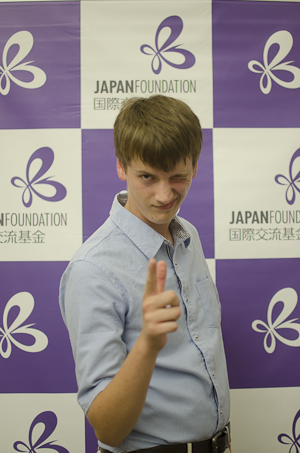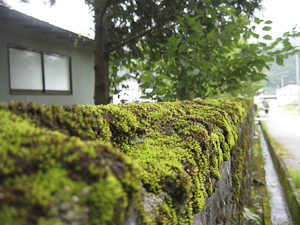

 Connor Veale
Connor Veale
Winston Churchill High School
San Antonio, TX
One month ago, I was lying in bed wide awake, excited with the prospect of once again departing my hometown of San Antonio to ultimately reach Japan. Six days of prior experience in Japan, including one in Osaka, was enough to whet my appetite for experiencing Japanese culture in person and give me a basic idea of what to expect from the JET Memorial Invitation Program. However, I was nervous about leaving the security of my localized life and traveling abroad with 31 unknown others with whom I had only one guaranteed thing in common: a passion for Japanese language and culture. And on top of 31 new American friends to make, there was a family of Japanese people expecting me to speak perfect Japanese with them, or so I thought. My thoughts raced with Japan's possibilities as well as my own insecurities that night as I attempted (in vain) to get a little rest before the big day. I didn't come close to realizing, however, the full potential of this program and the scale of the effect it would have on my understanding of the current state of post-3/11 Japan, modern Japanese culture, and of course the language itself.
Upon arriving in Japan, my nervous excitement continued and built as my fellow students and I got acquainted with the Institute which served as our dormitory and school during our time in Osaka. The beautiful campus surrounded by the somewhat familiar yet mysterious city instantly became home and it was difficult to immediately pick up and leave for Tohoku the next day, although perhaps that was due to the exhaustion from the over ten hour flight to Japan, our second flight in half a week. Either way, our hearts went "doki doki" as we boarded the plane from Osaka to Hanamaki chatting about the friendly airport security agents and silently wondering whether we forgot anything back at the Institute.
The first thing I noticed about the Tohoku region was the color green everywhere. Compared to the major cities in Japan where I travelled last year, this year's trip illustrated the beautiful landscapes of rural Tohoku in an indescribable way. The mountains surrounding one area of Rikuzentakata gave the land an appearance of a bowl of green grass, trees, and the undoubtedly Japanese homes. Walking in this area was somewhat cathartic, as the land demonstrated a contentedness in the tranquility of nature unheard of in suburban America and housed people who reflect that. Every person the students walked by either greeted us with a "Konnichiwa" or delightedly responded to us in a way that made us feel welcome and even at home, despite full awareness of the devastation left by the tsunami just a few miles from their homes.
Experiencing Tohoku's disaster areas was very difficult. Many of my friends cried upon viewing some of the devastation, and the rest of us were too shocked by what we saw for any tears. However, we all felt that it was an important experience for us to understand how Tohoku is coping with the disaster and to get a firsthand view of actual disaster areas over a year after the tsunami hit. I'm sure all of us were surprised to find piles of debris as tall as buildings, as the news coverage of 3/11 and its aftermath has dwindled down to occasionally referencing the pockets of radiation near the Fukushima Daiichi plant. In fact, during a summit for the JET-MIP participants and students from high schools in Rikuzentakata, many groups presented a desire to educate their peers in the United States on Tohoku's current state upon returning home. Tohoku wasn't all a disaster area, however, as we experienced in the cities of Sendai and Ishinomaki.
One highlight of our stay in Sendai was free time where groups of four participants were led by two local college students. Many of the MIP participants saw traditional aspects of Japanese culture such as temples and shrines, but my group experienced some of the youth culture of Japan such as using a purikura machine, visiting a karaoke box, and shopping for Japanese CDs. In Ishinomaki, we had the chance to speak with JET ALTs, Japanese high school students, and Japanese adults involved in an English conversation club. All of the students had fun throughout the Tohoku trip, but at the same time most became much less hesitant to speak Japanese and that was an invaluable development for everybody that contributed to how much we learned from our homestay in Osaka as well as the trip in general.
After returning to Osaka, my fellow participants and I participated in a preparation for the homestay which included a lesson on Kansai dialect, the Japanese that is spoken in the region of Japan that includes Osaka and Kyoto. I particularly enjoyed this lesson, not only for its benefit during my homestay but also because of the engaging style of teaching used by the teachers of the Institute. The lesson stuck and helped greatly at all times in Osaka, and it was always fun to get a little chuckle out of the security guards thanking them with “Ookini.” However, I knew I would need to work hard on my Kansai dialect once I met Ryo, the student at whose house I would spend the following two days.
My two days with Ryo and his family were difficult, but very rewarding. Ryo’s father spoke with very thick Kansai dialect and was at times difficult for me to understand, but he and I became very close over those two days. The whole family treated me as one of them and showed me what it truly means to live in Japan. This experience for me is irreplaceable because of the understanding I have gained about Japanese culture as well as the confidence in speaking Japanese I lacked before my homestay. I feel this confidence will propel me forward in my studies of the language and allow me to prepare myself better for work with the JET program and beyond in Japan.
Throughout each day of the memorial invitation program, we gained a lot of understanding of how Monty Dickson and Taylor Anderson grew to love Japan so much. Visiting the towns in which they taught added a personal connection to the experience and gave us a closer and personal look at the effects of the 3/11 disaster. The legacies of Ms. Anderson and Mr. Dickson have inspired an increased passion for Japan in all of us, and personally I have decided to strive to learn Japanese like Monty Dickson, who according to his sister was a dedicated enough man to transition from struggling with Japanese to having mastered the language. Taylor Anderson’s father once told us about his daughter’s optimistic attitude, citing one day where her car was broken into and she responded by taking pictures of it all, laughing and smiling in all of them. This story touched me and has inspired me to live my life with a positive outlook.
I am grateful to Taylor Anderson and Montgomery Dickson for setting a wonderful example for myself to follow and others interested in the JET program. I am also grateful to the Japan Foundation who worked diligently to ensure everything on this program ran smoothly. Without this program, I would have never learned about these two wonderful people who proved that life in Japan is nothing short of incredible.

This picture shows the natural color scheme and the way it represent the harmony between man and nature in Japan.